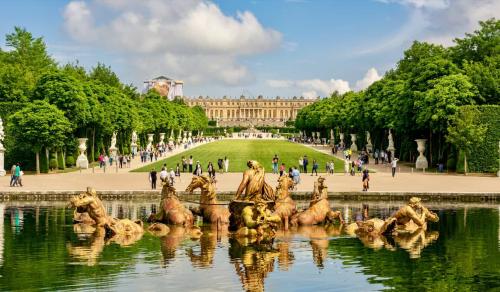The Ultimate Guide to Visiting Versailles Palace
Versailles is a testament to the absolute monarchy that defined France’s history, a place full of opulence and grandeur. This UNESCO World Heritage site is not only an architectural marvel but also a rich tapestry of art, history, and culture.
An estimated 10 million people visit this extravagant palace each year. It is the most popular attraction in the country after the Eiffel Tower. This detailed visitor’s guide will help you avoid the crowds, discover what to see and do, and make the most of your trip!
Because it’s one of my favorite spots in Paris, I want to make sure you have the best time and avoid all the tour groups.
You’ll learn everything you need to know about the Palace of Versailles in this comprehensive guide, from its fascinating history to practical travel tips.
Here are some key takeaways
Consider guided tours for a more in-depth experience by booking tickets in advance.
Wear comfortable walking shoes and dress appropriately for the weather.
From Paris, the RER C train is the easiest way to reach Versailles.
Allow plenty of time to explore the beautifully manicured gardens.
Bring snacks and enjoy the scenic views while relaxing in the gardens with a picnic.
Table of Contents
- History of The Palace of Versailles
- How to Visit the Palace of Versailles
- Travel Tips for the Palace of Versailles
- How to Get to the Palace from Paris
- Frequently Asked Questions About the Palace of Versailles
- Key Takeaways
The History of Versailles Palace
When King Louis XIII built Versailles in 1623, it was a hunting lodge. As a result of Louis XIV moving the royal court to Versailles in 1682, it underwent a grand transformation. The move was strategic, intended to isolate the court from the influence of Paris and to exert control over the nobility.
An Overview of the Grand Design
The “Sun King,” Louis XIV, envisioned a palace that reflected the monarchy’s absolute power. Louis Le Vau and André Le Nôtre, two of the architects and artists who worked on Versailles, combined classical architecture with exquisite gardens, fountains, and sculptures. Featuring lavish decorations, gilded moldings, and stunning frescoes, the palace embodies the Baroque style.
The Cultural Hub
Besides being a residence, Versailles became a cultural center. It hosted elaborate parties, artistic performances, and diplomatic meetings. Arts flourished, and fashion set the trends for Europe on this stage of opulence during the French monarchy.
Versailles’ lavish lifestyle, however, came at a price. As a result of discontent among the common people, the monarchy fell during the French Revolution. A storm stormed the palace in 1789, forcing the royal family to return to Paris.
Legacy and preservation
Symbolizing France’s royal past, the Palace of Versailles stands today. The site was designated a UNESCO World Heritage Site in 1979 and attracts millions of visitors every year. Future generations will be able to admire its grandeur thanks to ongoing restoration efforts.
Personal Insight: “Walking through the Hall of Mirrors, with its glittering chandeliers and reflections, I felt like I was transported back to a time when royalty ruled and every detail was a statement of power. The history surrounding this palace is palpable, making it a must-visit for anyone who loves culture and history.”
Here are some tips on how to visit the Palace of Versailles
If you want to experience the Palace of Versailles’ full grandeur, you’ll need to plan ahead. Make the most of your visit by following these tips:
A ticket is required for admission
A ticket is required to enter the Palace of Versailles. The following are the different ticket options:
| Ticket Type | Price (2024) | Details |
|---|---|---|
| Passport for the Palace | €20 | Includes access to the Palace, the Gardens, and the Trianon. |
| Gardens Only Ticket | €12 | Access to the gardens is available during musical fountain shows. |
| Trianon Ticket | €12 | Access to the Grand Trianon and Petit Trianon. |
| Guided Tour | €30-€70 | Includes a tour guide; prices vary based on the tour type. |
Tip: Purchase your tickets online in advance to avoid long lines, especially during peak tourist seasons.
Opening Hours
The Palace of Versailles is open every day except Mondays. Here are the typical hours:
- Palace: 9 AM to 5:30 PM (until 6:30 PM during the summer months)
- Gardens: 8 AM to 8:30 PM (until 6:30 PM in winter)
- Trianon: 12 PM to 6:30 PM (last admission at 5:45 PM)
Guided tours
Consider joining a guided tour for a richer experience. On a self-guided tour, you might miss out on insights into the palace’s history, art, and architecture. Online or at the entrance, tours often include exclusive areas.
What to See
The Palace of Versailles is vast, with numerous rooms and gardens to explore. Here are some highlights:
- The Hall of Mirrors: Perhaps the most famous room, adorned with 357 mirrors, it served as the venue for the signing of the Treaty of Versailles in 1919.
- The King’s Apartments: A series of opulent rooms, each with unique decor that reflects the lifestyle of the French monarchy.
- The Gardens: Designed by André Le Nôtre, these gardens feature beautiful fountains, sculptures, and meticulously manicured lawns.
- The Grand Trianon and Petit Trianon: Smaller palaces on the grounds where kings and queens could escape the formality of court life.
Personal Insight: “I was particularly enchanted by the Gardens of Versailles. Strolling through the perfectly symmetrical hedges and hearing the distant sound of the fountains was like stepping into a living painting. The sheer scale of it all is breathtaking.”
Travel Tips for the Palace of Versailles
Visiting the Palace of Versailles can be an unforgettable experience if you plan ahead. Here are some essential travel tips:
Best Time to Visit
- Peak Season: April to October is the busiest time, with warm weather and many tourists. If you don’t mind the crowds, this is a great time to enjoy the gardens and outdoor activities.
- Off-Peak Season: November to March sees fewer visitors, which means shorter lines and a more intimate experience, though some outdoor attractions may be closed.
Dress Comfortably
You’ll be doing a lot of walking, so wear comfortable shoes. The palace has cobbled paths and expansive gardens, so be prepared for some exploration.
Bring a Guidebook or App
A good guidebook or a mobile app can enhance your visit, providing context and information about the various rooms and artwork. The official Palace of Versailles app is a great resource for this.
Stay Hydrated and Snack Smart
There are cafes on-site, but they can be pricey and crowded. Consider bringing a water bottle and some snacks to enjoy while exploring the gardens.
Consider a Picnic
If the weather is nice, pack a picnic to enjoy in the gardens. This adds a personal touch to your visit and allows you to soak in the beauty of your surroundings.
Personal Insight: “I remember sitting on the grass with a homemade sandwich, looking out at the fountains while the sun set. It was one of those moments where you feel grateful to be in such a beautiful place, far removed from the hustle of the city.”
How to Get to the Palace from Paris
Getting to the Palace of Versailles from Paris is relatively straightforward. Here are the best options:
By Train
The RER C train is the most popular way to reach Versailles. Here’s how:
- Departure: Catch the RER C from central Paris (stations like Saint-Michel or Musée d’Orsay).
- Destination: Get off at the Versailles Rive Gauche station. The journey takes about 40 minutes.
- Walk: From the station, it’s a 10-15 minute walk to the palace.
Tickets: A round-trip ticket costs around €7-€8.
By Bus
Several bus lines (such as the 171) run from Paris to Versailles. This option is typically less crowded than the train and offers a scenic route.
By Guided Tour
Many travel companies offer guided tours that include transportation. This can be a stress-free way to visit, as it takes care of both travel and entry to the palace.
By Car
If you’re driving, the Palace of Versailles is about 30 kilometers from central Paris. Note that parking can be limited, especially during peak times, so arriving early is advisable.
Personal Insight: “I chose the train option, and it was so easy! The ride was comfortable, and I got to see the charming suburbs of Paris. The walk from the station to the palace only heightened my anticipation.”
Frequently Asked Questions About the Palace of Versailles
1. How long should I spend at the Palace of Versailles?
Most visitors spend about 4-6 hours at the palace, including time in the gardens. If you plan to explore the Trianon estate, consider allocating a full day.
2. Are the gardens free to enter?
The gardens are free to enter except on days when the musical fountain shows are held. During these events, a separate ticket is required.
3. Can I take photos inside the palace?
Photography is allowed in most areas of the palace, but flash photography and tripods are prohibited. Be respectful of the art and other visitors.
4. Is there food available at the palace?
Yes, there are several cafes and restaurants on-site, but they can be crowded and pricey. Bringing your own snacks is a good idea.
5. Are guided tours worth it?
Absolutely! Guided tours provide valuable insights and help you navigate the vast estate. Plus, some tours offer access to areas not open to the general public.
6. What should I wear?
Dress comfortably, especially if you plan to explore the gardens. Wear shoes suitable for walking, as the grounds are extensive.
Personal Insight: “When I visited, I opted for a guided tour, and it made all the difference. Our guide shared stories and facts that brought the history to life, making it a truly enriching experience.”
A trip to the Palace of Versailles is more than just a vacation; it’s an experience that immerses you in the opulence of French history. Every corner of Versailles tells a story, from the breathtaking architecture to the meticulously maintained gardens. Get ready to create unforgettable memories at this iconic landmark by packing your bags, grabbing your camera, and getting ready to explore!








